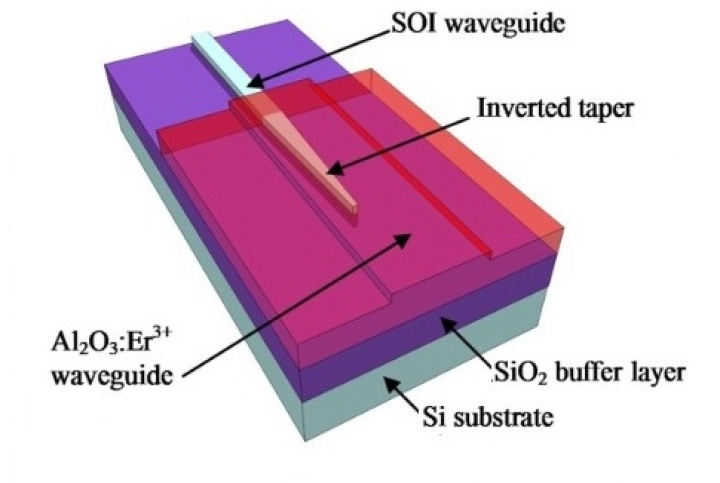First Ultrafast Silicon & Erbium Light Amplifier

Laura Agazzi of the University of Twente, says she has contributed to fabricating, for the first time, an optical chip which uses 'traditional' silicon waveguides combined with an erbium containing material.
This material is claimed to make on-chip amplification of the light signal possible at very high speeds.
In her Ph.D. thesis, Laura Agazzi demonstrates a working chip, which can show a potential gain, or amplification, at speeds of up to 170 Gbit /s. The prototype chip achieves a gain of 7.2 dB (a factor of 2.3) with infrared light having a wavelength of 1533nm.
Light in optical chips often find its way through channels of silicon.
For example, in an optical fibre, light is emitted by a chip consisting of a structure of channels which are cleaved and linked. Silicon lends itself well for this, but it remains a passive light guide.
And to amplify the light from the chip, more is needed.
Other materials which have been investigated for this purpose include compound semiconductors such as gallium arsenide. But materials which are doped with the rare-earth metal erbium are also suitable.
Agazzi say that until now, silicon and erbium-doped single chips have not been used for this purpose.
The prototype chip is a start, and has been delivering good results. For example, a laser with an extremely narrow line width of 1.7 kilohertz has also been fabricated. Agazzi says that in order to enhance light emission from the chip, integration is needed.
So her discovery is not just limited to telecommunications. It could also be used for sensor applications, in order to detect very small particles.
The schematic above shows the chip which incorporates a silicon optical waveguide (SOI: silicon on insulator) as well as erbium doped aluminium oxide waveguide.
Laura Agazzi has extensively studied the optical properties of Al2O3 doped erbium in order to understand the mechanisms that get in the way.
She found that one of the processes that could hinder the operation is Energy Transfer Up conversion, or ETU. This is a process of interaction between two charged particles, or ions.
She says that for a high gain, or amplification, you need a lot of erbium ions in the material, but this increases the risk of ETU occurring.
Using modelling, she gained a better insight into how modification of the host material can lower or increase the amplification.
This research was conducted by Laura Agazzi at MESA and the Institute for Nanotechnology at the University of Twente. Her Ph.D. thesis, entitled, "Spectroscopic Excitation and Quenching Processes in Rare-Earth-Ion Doped Al2O3 and Their Impact on Amplifier and Laser Performance," explores this work in depth. The thesis or a summary are available in digital format.
































